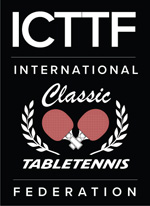Tip of the Week
Topspin
I'm often amazed at how the world of table tennis is divided between two types: those who use the full power of topspin in their games, and those who don't. This doesn't mean looping every ball, but it does mean using topspin to control your offensive shots and often your defensive ones as well. Even when doing simple forehands or backhands a little topspin goes a long way. I know; I sometimes hit the ball too flat and pay the price.
It's actually very simple. Topspin pulls the ball down. This means balls that would go off the end instead curve down and hit the table. It's like having an additional couple of feet of table to aim for. The best way of demonstrating it is to drop a ball near the end line, and hit it as it reaches table level. Try smashing flat, and watch it go off. Then smash with a little topspin, and watch as it occasionally hits the far side, but only barely. Then loop kill it, and watch how it often hits the table with two feet to spare. (Of course, you have to be able to do these shots at a relatively high level to do the above - but if you can't, then get some top player to demonstrate, or just trust me.)
When attacking, you don't have the entire 4.5 feet of the far side of the table to aim for. On many shots, if you don't use topspin, you might only have the last few inches to aim for. With topspin, the size of your target goes up tremendously.
And we haven't even gotten into how topspin makes it easier to return hard-hit balls (again, larger target), or how the topspin jumps both on the table and off the opponent's racket, making it harder for them to make good returns. There's a place for all types of spin in table tennis, but from the intermediate to the advanced levels, topspin is king.


 Photo by Donna Sakai
Photo by Donna Sakai




